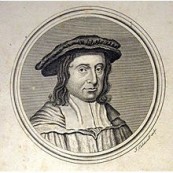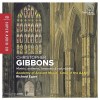Biography
Christopher Gibbons (1615–1676) was an English composer and organist. He was the second son, and first surviving child of the composer Orlando Gibbons.
As a child, Gibbons sang in the Chapel Royal under the direction of Nathaniel Giles. Gibbons most likely studied initially with his father as Orlando Gibbons was the leading church musician with the courts of James I and Prince (later King) Charles. After his father's early death in 1625, Gibbons moved to Exeter to live, for a short period, with his uncle, and father's eldest brother, Edward Gibbons who was also a well-regarded church musician in London and Master of the Choristers at Exeter Cathedral.
In 1638, Gibbons, himself already a noted organist and Gentleman Chorister of the Chapel Royal and Westminster Abbey, succeeded organist Thomas Holmes and began playing in the Winchester Cathedral. However, the English Civil War - which began in earnest in 1641 - lead to a suppression of Church music, and put an end to Gibbons' position. He fought for the Royalist cause but, after the execution of Charles I and the collapse of Royalist resistance following the Battle of Worcester (1651), Gibbons moved to London where he lived from late in 1651 to his death in 1676. Worthy of mention is his work with respected contemporary Matthew Locke on the masque or quasi-opera Cupid and Death in 1653 - it is one of the few works from this period that still exists in full score. From 1653 until the restoration of the monarchy in 1660, Gibbons made his living primarily as a music teacher and, more occasionally, as a composer of incidental music for the restricted theatres of Commonwealth London.
With the return of Charles II to the English throne, Gibbons, in part because of his loyalty to the crown, was immediately welcomed into the artistic fold of the new court and, with church music again flourishing, was swiftly reinstated as a Gentleman and Organist of the Chapel Royal. He subsequently became one of Charles' most important post-Interregnum composers, teachers and musical advisors. Christopher Gibbons was one of the few Royalist musicians not to flee England for the safety of the continent (such as did Nicholas Lanier) during the Interregnum - and this may explain Gibbons' rapid rise in the king's favour - for it had been no easy thing to remain a known Royalist in Cromwell-controlled London and had cost some their lives.
Gibbons was well-known and influential in the later part of his life (1660-1676) - he is recorded several times in the diaries of Samuel Pepys - and importantly (given his direct link to the musical tradition of the Elizabethan period) he was responsible for the nurturing of several great Restoration composers including Blow, Humfrey and, most significantly, Henry Purcell. He became the first recorded organist of St Martin-in-the-Fields in 1674, where it is likely he composed his Voluntary for Double Organ, using the two distinct manuals of the instrument at St Martin's at that time.
His music is little known - and few examples exist of any - but it is as a teacher and upholder of the English musical tradition - before the almost 30-year interruption to it by those socioeconomic and cultural struggles that culminated in the English Civil War - that secures for him a substantial role in the rebirth of English music, particularly church music, during the second half of the 17th century.







